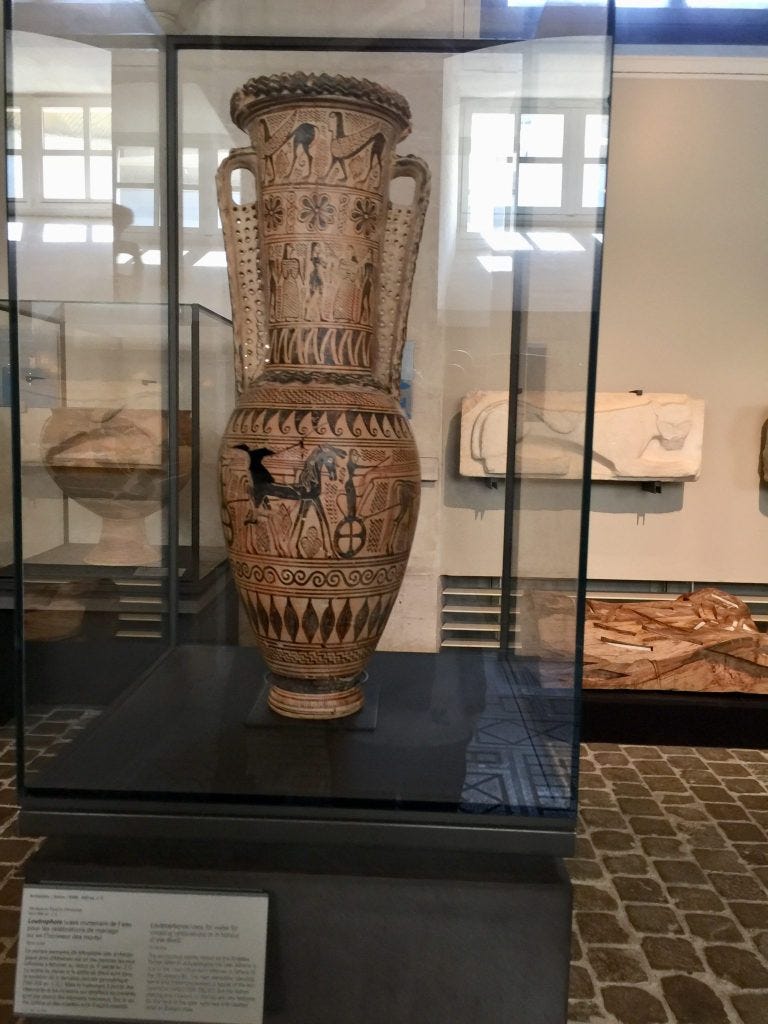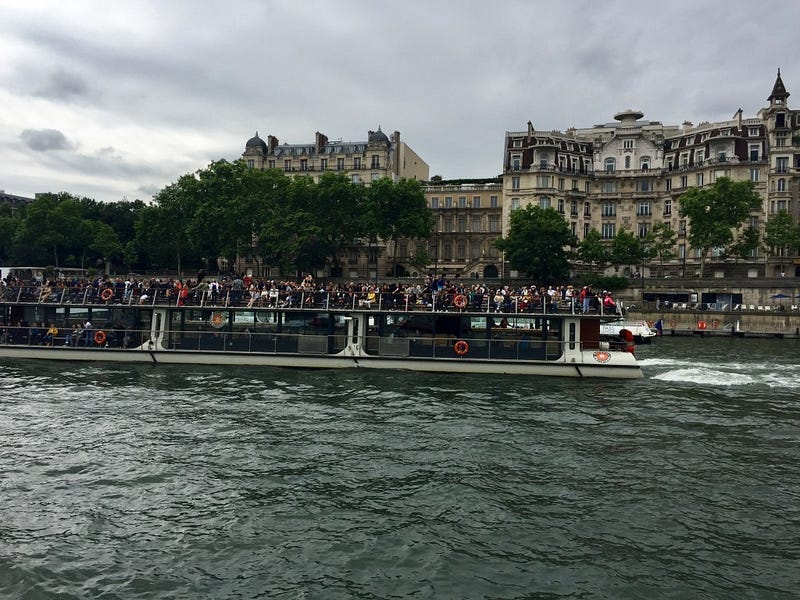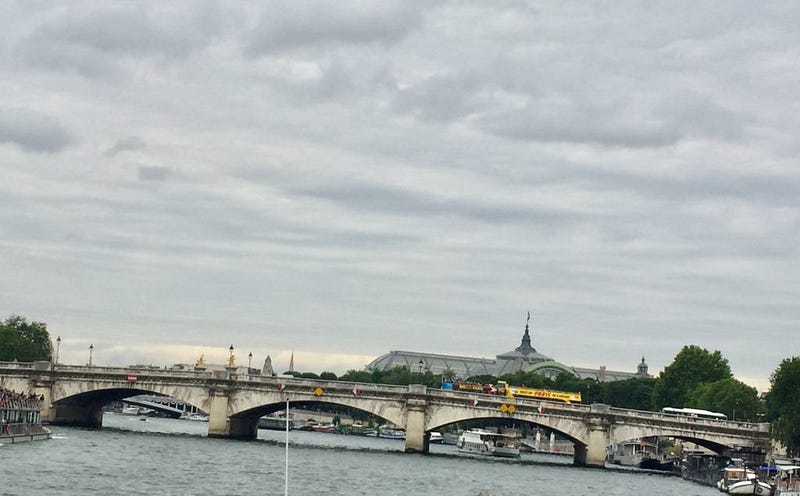Now that we had seen most of the major attractions, we were ready to discover some off-beat attractions on our last day in Paris.
In one of the brochures on walking tours, we spotted a tour titled, HIDDEN GEMS AND SECRET PARIS — a local Parisian shares hidden treasures that tourist maps will not show.
Those of you who have read my post on Valparaiso know that I love walking tours. They give such a good local inside knowledge about the landmarks and culture, people, food, and local idiosyncrasies. And usually, the guides are very amusing.
The meeting point for the tour was by the horse statue outside the Louvre.
About eight of us were waiting for the guide when a young man arrived in a pink vest. He looked around, waited for a few minutes to see if anyone else was joining, folded his pink jacket, and put it away, announcing it was hideous.
“Okay. My name is Nicole. I am your guide for Hidden Gems and Secret Paris. I am a student, and this is my way of making some extra money for travel. So at the end of the tour, pay based on how much you liked the tour, i. e. generously.”
Actually he didn’t say that. He forgot. But we knew the deal.
Today’s post is mostly Nicole’s narration.
Arc of Carrousel
“We will start from right here. All of you probably know about the Arc de Gaulle but may not be about the triumphal arc right in front of you. It is called the Arc of Carrousel. Napoleon built it in 1806–1808 to honor his army and celebrate their victories. It used to be the thing back then, to build something to honor the armies.
It is aligned with the obelisk of the Concorde, the centerline of the Champs-Elysées avenue, and the Arc de Gaulle (also known as the Great Arc of Triumph). When it was built, Napoleon didn’t like it. He thought it was not grand enough for his army. So he built another one, the Great Arc of Triumph.”

Obelisk of Concorde
“By the way, do you know the story about the obelisk in Concorde?”
We all shook our heads.
“The obelisk in the square of Concorde is one of two 3,000 years old obelisks that originally stood outside Luxor Temple in Egypt. They were given to France by Muhammad Ali Pasha, Ruler of Ottoman, in exchange for a French mechanical clock. But, unfortunately, it took a French ship more than a year to bring it to France.
After the obelisk was taken, the mechanical clock provided in exchange was discovered to be faulty. King Louis-Phillip said to the Ottoman ruler to keep the second obelisk. It still stands outside of Luxor Temple. And so does the worthless clock, in a clock tower somewhere in Egypt. And ironically, it is still not working.”

Obelisk in the square of Concorde 
Obelisk outside Luxor Temple
Metro Stations
We were herded out from the Louvre complex to the entrance of a subway.
“You see this entrance to the subway. It is green and subtle. The same architect designed all old subway entrances, and they all look the same. But they allowed the new artists to design new entrances. This one is designed by an artist famous for his work with glass made from volcanic lava. Which one you like better?”
“The old one,” we all said in unison.

Old subway entrance 
New subway entrance
Comedie Francaise
Just opposite the new subway entrance was the Comédie-Française theatre.
“Comédie-Française is one of the few state theatres in France. It was established in 1995 to honor French playwright, actor, and poet, Molière, widely regarded as one of the greatest writers in the French language. In 1673, during a production of his final play, The Imaginary Invalid (about a rich man who stages his death while his relatives fight around him for his inheritance), Molière died on stage after playing the last scene of the last play. Each year the theatre holds free performances on the anniversary of his death.”

The Royal Palace
“From the theatre, we will be walking to the garden side of the Royal Palace, which is now the seat of the Ministry of Culture, the Conseil d’État, and the Constitutional Council.
Cardinal Richelieu originally built the Royal Palace in 1639. He built it because he wanted to marry the queen(not sure which one he was referring to). Upon his death in 1642, the palace became the property of the King and acquired the new name Palais-Royal. After Louis XIII died the following year, it became the home of the Queen Mother Anne of Austria and her young sons Louis XIV and Philippe, Duc d’Anjou, and her advisor Cardinal Mazarin.
Louis XIV felt unsafe in the Royal Palace and gave it to his brother, who turned it into Las Vegas with all kinds of gambling and prostitution. They became the social center of the capital. The gathering at the Palais-Royal was famed all around the capital as well as all of France. At these parties, the crème de la crème of French society came to see and be seen.
Have a look at the trees in the garden. I used to come here as a child, and for a long time, I kept on thinking that the trees are square.”


Place Des Victoires
Walking through several streets, we reached an open circular area. It was, in fact, a Square.
“This is Royal Square. Paris has five of them. Kings usually commissioned these squares as a symbol of the King’s grandeur.
Although Place de la Concorde is the biggest and most popular, Place Des Victoires is special. Calm and graceful, the circular shape of the square was at the time of its construction an architectural revolution.
In the center is the statue of King Louis XIV, whose place was dedicated in honor of his military victories. This statue has besides been melted during the French Revolution to make guns! It was rebuilt in the mid 19th century.
Now notice something. The horse’s legs are up, which usually means that the rider died in a battle. However, Louis XIV never went to any battle let alone die in one. So this is a lie.”

Place des Petits-Pères
We stood in front of a church, and Nicole started his commentary.
“We French like to wage wars which we usually lose. But then we bring back souvenirs. For example, this church is built from the bricks looted from Rome.”

Nicole promised to show us an arcade built to provide a safe and attractive place for shopping in the olden days. So he took us to the most beautiful one.

There he gathered us in front of a Café and told us the story of Eugène François Vidocq.
“Vidocq was a criminal whose life story inspired several writers, including Victor Hugo, Edgar Allan Poe, and Honoré de Balzac. He was so good that the police asked him to help them catch other criminals. Thus, Vidocq is regarded as the father of modern criminology and the French police department. He is also regarded as the first private detective.
Above this cafe is a theatre. Vidocq was a patron of that theatre. In those days, this theatre regularly presented crime stories in the form of melodramas.”
Our tour ended in the Royal Palace gardens. We walked from there to Notre Dame and watched it up and close. It was majestic. Of course, it was heavily fenced since the fires, but hundreds of tourists were still taking photos in front of it.

We walked the famous street Ile Saint-Louis, had lunch at St Regis, and stood in the line to have Paris’s famous Berthillon gelato.


We came back to the hotel to have a well-deserved rest. In the evening, there was only one thing left to do — climb the Eiffel Tower.

It took us only twenty minutes to climb 700 stairs to get to the second level, but three hours in different queues to get to the top by lift.
We got back just in time to see the midnight light show. A perfect setting to wish my darling husband Happy Birthday.

Thank you for reading my travel stories. They were no Gulliver Travels but I had a great time writing them knowing that some of you are waiting for them and will keep pestering me until I do. In the future, I intend to write more posts based on my previous travels as well as forthcoming.










































































